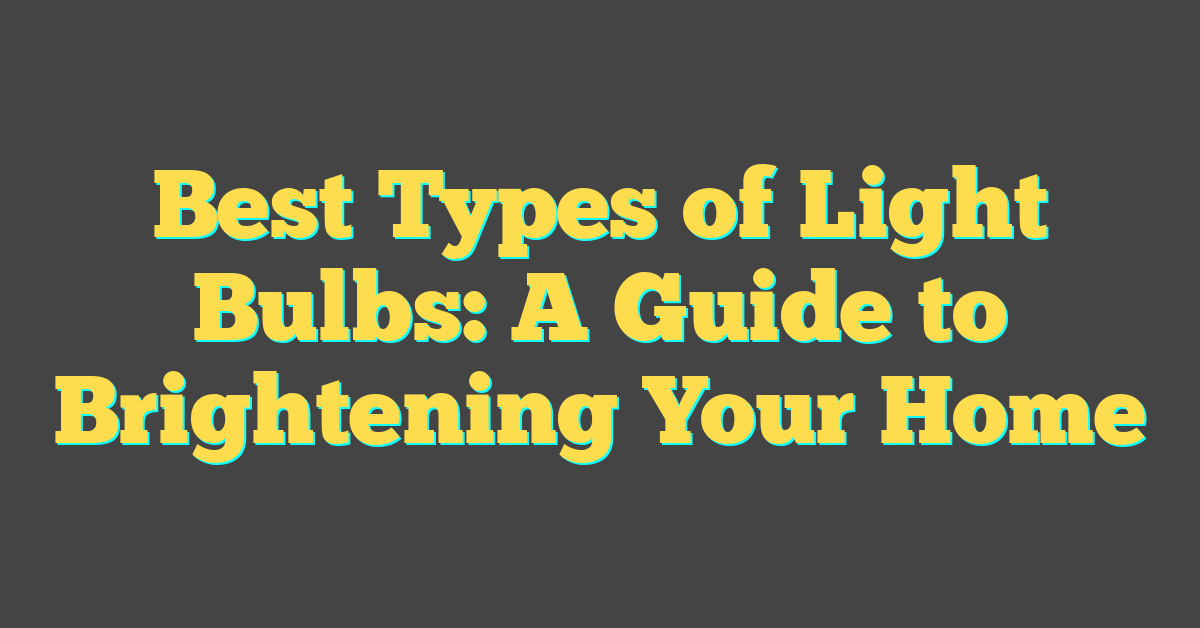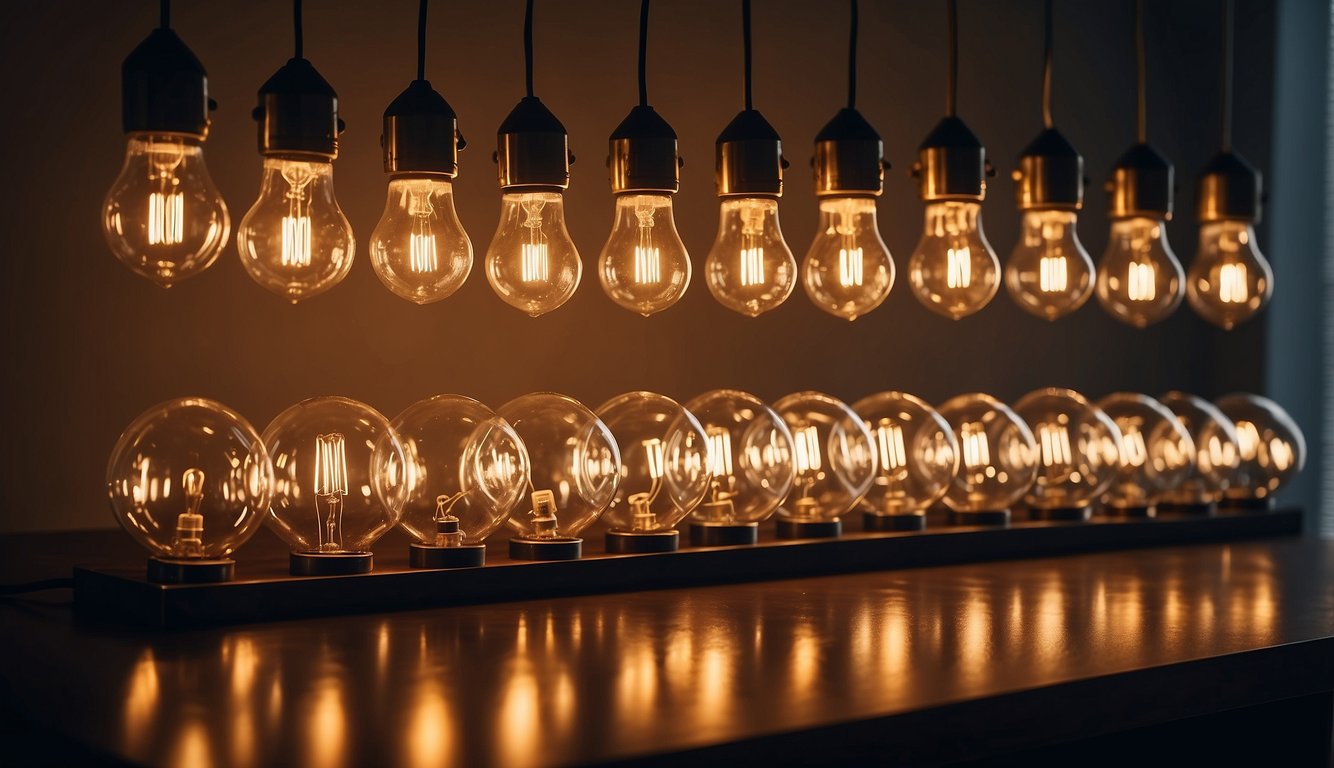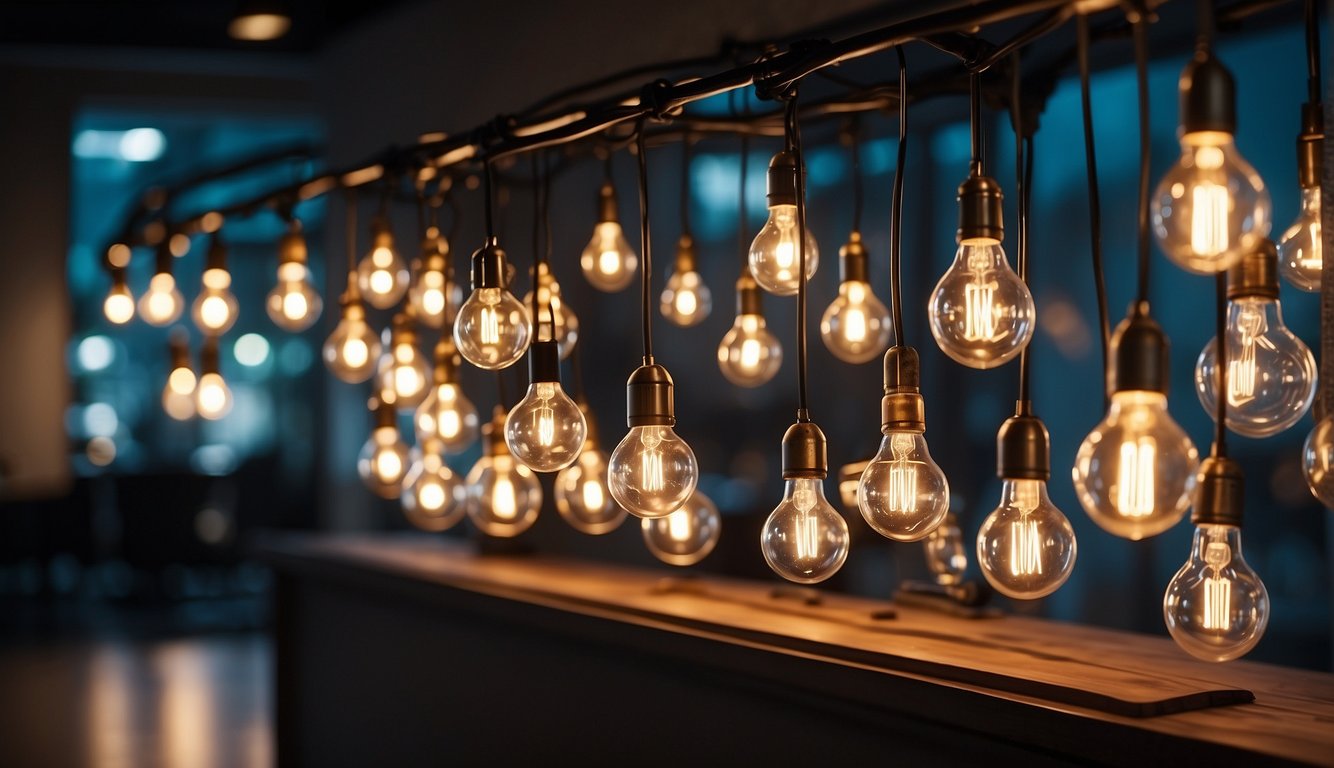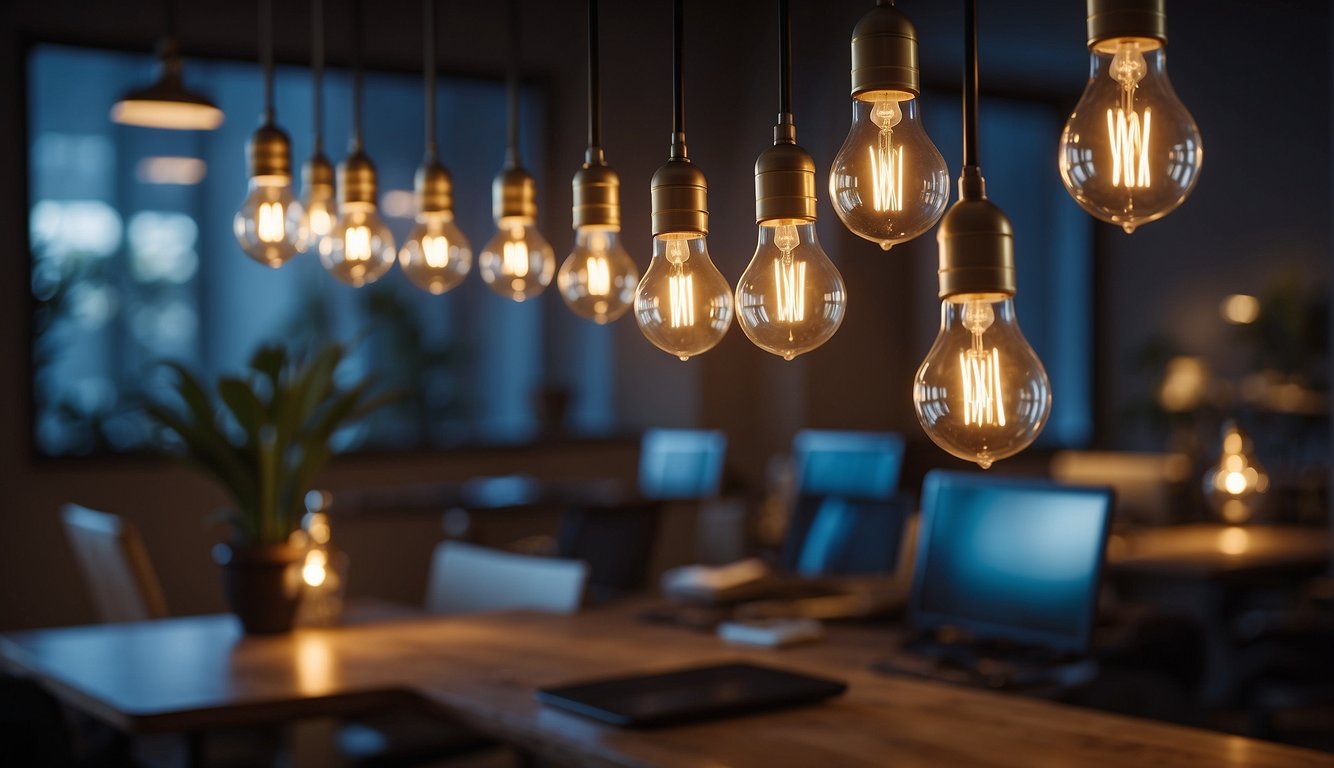Selecting the best types of light bulbs for your home involves understanding the various options available and how they cater to different lighting needs. Light bulbs are essential in shaping the ambiance of a space; they can influence mood, productivity, and even the perceived size of a room. The technology surrounding light bulbs has evolved dramatically, offering a range of bulb types that can save energy, last longer, and offer adjustable brightness and color temperatures to suit any setting.


When considering a new bulb purchase, it’s essential to weigh factors such as energy efficiency, color temperature, and the purpose the light will serve. Whether you need clear, focused light for a home office, soft ambient light for relaxing evenings, or efficient lighting solutions that cut down on electricity bills, there is a perfect bulb for every area of your home. Understanding these factors can lead to informed decisions that enhance comfort while being kinder to the environment and your wallet.
Key Takeaways
- Effective lighting choices enhance both the functionality and ambiance of a space.
- Advancements in bulb technology provide a variety of energy-efficient and long-lasting options.
- Tailoring light bulb choices to specific room functions can optimize both aesthetics and utility.
Types of Light Bulbs
When you’re choosing the perfect light bulb for your needs, it’s important to consider the various types available. Each type offers different benefits and is suitable for specific applications.
LED Light Bulbs
LED (Light-Emitting Diode) bulbs are highly energy-efficient and have an exceptionally long lifespan. They consume up to 90% less energy than traditional bulbs, making them an environmentally friendly choice. You can enjoy a wide array of color temperatures and designs, suitable for everything from cozy home lighting to precision task lighting. For further details about LED bulb pros and cons, see Light Bulb Types: How to Choose the Best Light Bulbs – Lowe’s.
Halogen Bulbs
Halogen bulbs are a type of incandescent light that produce a bright, white light, often used in spotlights and floodlights. They’re more energy-efficient than standard incandescent bulbs but not as efficient as LEDs or CFLs. As they operate at higher temperatures, halogens are typically hotter to the touch. Learn about their varied applications at Types of Light Bulbs – The Home Depot.
Incandescent Bulbs
Incandescent bulbs are the traditional bulb type many are familiar with, providing a warm glow that’s excellent for ambiance. However, they’re not energy-efficient and have a shorter lifespan compared to other modern bulb types. These bulbs are often used in applications where a softer light is preferred.
Compact Fluorescent (CFL) Bulbs
CFL bulbs are a smaller version of standard fluorescent lights, designed to replace incandescent bulbs. They use about one-third of the energy and last ten times longer. CFLs need a bit more time to reach full brightness, which is something to consider for certain uses.
Fluorescent Light Bulbs
Fluorescent bulbs are most often used in commercial spaces or areas requiring long, overhead lighting. They’re more energy-efficient than traditional incandescents and come in tube-shaped forms. Fluorescents provide consistent light over large areas and are available in different hues.
Selecting the right light bulb depends on your specific needs, whether it’s energy efficiency, longevity, or quality of light. Each bulb type has its unique set of characteristics to consider.
Comparing Energy Efficiency
When you’re choosing light bulbs, considering energy efficiency is crucial as it directly impacts the electricity usage and the cost associated with lighting your home. Different bulb types offer varying degrees of efficiency and lifespan, which are important for your wallet and the environment.
LED vs. Incandescent
LED bulbs are at the forefront of energy efficiency. Compared to traditional incandescent bulbs, LEDs use about 75% less energy and can last up to 20,000 hours or more. While incandescent bulbs may cost less upfront, they operate at a higher wattage, and their shorter lifespan means you’ll be replacing them more frequently.
Example:
- LED: Uses approximately 10 watts for the same amount of light.
- Incandescent: Uses approximately 60 watts for the same amount of light.
CFLs vs. Halogen
Compact Fluorescent Lamps (CFLs) are another energy-efficient option that uses about 70% less energy than traditional halogen bulbs. CFLs, with their distinct curly shape, offer a longer lifespan than halogens but may take a moment to reach full brightness when you switch them on.
In contrast, halogen bulbs provide instant brightness and a warm light at a lower initial cost. However, they are far less energy-efficient, with a significantly shorter lifespan than CFLs, leading to more frequent replacements.
Comparison:
- CFL: Approximately 14 watts for the same amount of light.
- Halogen: Around 42 watts for the same amount of light.
« Energizer LED Headlamp Pro260 Review: Top Pick for Trails?
MIOISY Headlamp Rechargeable Review: Top Outdoor Companion? »
By understanding these differences, you can make informed decisions that benefit both your energy bills and the environment.
Understanding Brightness and Color
When selecting light bulbs, understanding lumens and watts influences brightness, while the color temperature scale defines the hue of light. Both aspects affect the light color and ambiance of a room, tailoring the atmosphere to your needs.
Lumens vs. Watts
Lumens measure the brightness of a light bulb—higher lumens mean a brighter light. Conversely, watts quantify the energy a bulb uses. Historically, brightness was associated with higher wattage, but modern LED bulbs deliver high brightness for far fewer watts. For instance, an LED bulb with just 10 watts might provide the same brightness as a 60-watt incandescent bulb.
Color Temperature Scale
The color temperature is expressed in Kelvins (K) and impacts the light color. The scale ranges from warm to cool:
- Soft white (2700K-3000K) provides a warm, calming glow akin to incandescent bulbs.
- Bright white (3500K-4100K) offers a more neutral, balanced light.
- Cool white (5000K-6500K) delivers a crisp and invigorating light, similar to daylight.
Visualizing the scale helps you choose the appropriate bulb for the desired effect in your space.
Light Color and Ambiance
The light color greatly influences the ambiance of a room. Warm white creates a cozy atmosphere, suitable for bedrooms or living areas, while bright white or cool white can enhance focus and energy, ideal for kitchens or offices. The right choice can make a room appear more inviting or provide functional, task-oriented lighting. Remember, ambient light isn’t just about visibility; it’s also about setting the right mood.
Bulb Shapes and Fittings
Choosing the right light bulb isn’t just about the type or brightness; it’s also important to select the correct shape and base for your fixture to ensure it fits and functions properly.
Common Light Bulb Shapes
- A19: This is the classic shape that you’re most familiar with. Ideal for table lamps and fixtures where the bulb is visible.
- BR30: These bulbs have a wide, bulging shape that diffuses light. They’re often used in recessed can fixtures.
- PAR38: These are larger, with a more focused beam of light, perfect for outdoor floodlights or track lighting.
- GU10: Characterized by its twist-and-lock base, it’s commonly found in track lighting.
Bulb shapes are designed for specific lighting effects and applications, so always check the shape compatibility with your fixture.
Base Codes and Sockets
E26: The standard socket size in the U.S. for a wide range of bulbs, including A19 and BR30.
GU10: Not just a bulb shape, GU10 is also a base code indicating a twist-and-lock mechanism, differing from the typical screw-in bases.
Remember to match the base code of your bulb to the socket in your fixture. Using the wrong base can result in poor function or safety issues. Here’s a quick reference:
| Bulb Shape | Base Code | Common Use Case |
|---|---|---|
| A19 | E26 | General lighting and lamps |
| BR30 | E26 | Recessed and can lighting |
| PAR38 | E26 | Outdoor and security lighting |
| GU10 | GU10 | Track and accent lighting |
Selecting the proper base and shape ensures your light bulbs will fit securely and work correctly in your lighting fixtures.
Special Features of Bulbs

When selecting light bulbs for your home, you’ll want to consider features that can enhance the ambiance and adaptability of your lighting. Advanced options like Dimmable Lights and Smart Light Bulbs provide you with greater control over your environment, affecting mood and preventing issues like flicker.
Dimmable Lights
Dimmable lights offer you the flexibility to adjust the brightness in a room to suit your needs and preferences. It’s essential to pair these bulbs with compatible dimmer switches to ensure a smooth operation and to eliminate flicker. Here’s a quick glance at what you need to know:
- Compatibility: Ensure the bulb is marked as dimmable.
- Switch Types: Match the bulb with the correct dimmer switch type.
Using dimmable bulbs can greatly affect the mood and ambiance of a space, making it cozy and inviting.
Smart Light Bulbs
Smart light bulbs take lighting to a new level, combining traditional illumination with modern technology. They allow for remote control via smartphones or voice assistants, and here’s why they might just light up your life:
- Convenience: Control lights from anywhere, at any time.
- Features: Schedule on/off times, change colors, and set scenes for the ideal ambiance.
By incorporating smart light bulbs into your home, you’ll enjoy a personalized lighting experience that adapts to your lifestyle.
Optimal Lighting for Different Rooms
Choosing the right lighting for your home is essential as it can affect both the aesthetics and practicality of each room. You’ll want bright, focused lighting for tasks in some rooms and softer, diffused light for a relaxed ambiance in others.
Kitchen Lighting
In your kitchen, the heart of the home, both recessed lighting and ceiling fans with lights can ensure that the entire space is well-lit. For tasks like chopping vegetables or reading recipes, consider adding under-cabinet lights or pendants above the kitchen island for directed brightness where you need it most.
- Recessed Lighting: Great for overall brightness.
- Pendants: Ideal for counters and islands.
- Under-Cabinet Lights: Perfect for task lighting.
Bedroom Lighting
Your bedroom is your sanctuary, requiring lighting that can be both functional and soothing. Start with a central lighting fixture, like a chandelier or flush mount, for a touch of style and overall illumination. Bedside lamps or wall sconces provide focused light for reading in bed and bring in a softer light to help you wind down at night.
- Chandeliers: Stylish and illuminating for the entire room.
- Sconces: Functional for bedside reading.
- Lamps: Flexible light positioning and intensity.
Living Room Ambiance
In your living room, ambiance is key. Versatile lighting options can accommodate a variety of activities and moods. An overhead ceiling fan with a light kit or floor lamps can give you general ambient lighting, while sconces or track lighting add layers and can highlight artwork or architectural features.
- Ceiling Fan with Lights: Provides air circulation and ambient light.
- Floor Lamps: Can be moved around to where light is needed.
- Sconces/Track Lighting: Highlights specific areas or decor.
Remember, the best lighting plan is one that can adapt to your needs while complementing the design of each room.
Decorative and Task Lighting

When setting the right ambiance and ensuring functionality in your space, the lighting choices you make are vital. You’ll want to consider both the visual appeal and the practicality of the light fixtures involved.
Decorative Light Fixtures
Decorative lighting serves as a visual focal point and can enhance the aesthetic of a room. Edison bulbs offer a vintage charm, emitting a warm, amber light that creates a cozy atmosphere. They fit well in a variety of pendants and wall sconces, bridging the gap between form and function. These types of bulbs are not only light sources but also pieces of art that catch the eye and draw attention.
Effective Task Lighting
On the other hand, task lighting is all about functionality. It’s the concentrated light where you need it most, whether that’s over your kitchen counter, at your reading nook, or under your cabinets. Desk lamps and under-cabinet kitchen lights are common task lighting options. These fixtures provide the bright and direct light required for specific tasks, reducing eye strain and increasing productivity. To adjust the mood or intensity, dimmer switches can be a great addition to your task lighting solutions.
Health and Environmental Considerations
When considering light bulbs for your home, it’s essential to weigh the health and environmental impacts. Some bulbs contain materials that require special disposal, while others can affect your sleep patterns.
Mercury Content and Disposal
Compact Fluorescent (CFL) bulbs are known for their energy efficiency, but they contain mercury, a toxic substance that can pose environmental and health risks if the bulbs break or are improperly disposed of. You should dispose of CFL bulbs according to your local hazardous waste disposal regulations to prevent mercury from contaminating the environment.
Reducing Blue Light Exposure
Exposure to blue light, especially before bedtime, can impact your sleep quality by inhibiting melatonin production. Although LEDs are highly energy-efficient, they also emit a significant amount of blue light. To reduce blue light exposure, opt for LEDs that have a “warm” color temperature or consider using blue light filters in the evenings.
Choosing Long-lasting Light Bulbs
When you’re looking for light bulbs that won’t have you climbing ladders for replacements often, it’s wise to consider options with superior longevity and learn how to maintain them properly.
LED Lifespan
LED light bulbs are acclaimed for their longevity, often boasting a lifespan up to 25 times longer than traditional incandescent bulbs. LEDs typically last for about 25,000 to 50,000 hours of use, which means if you use your LED bulb for 8 hours a day, it could last for over 17 years.
Caring for Bulbs to Extend Life
- Avoid frequent on-off cycling: Constantly switching your bulbs on and off can shorten their lifespan. LEDs are durable but thrive with stable use.
- Proper Fixture Fit: Ensure your LED bulbs are not enclosed in tightly fitted fixtures unless they’re rated for it. Heat buildup can degrade performance.
- Clean Regularly: Keeping your bulbs dust-free helps maintain their efficiency and light output, thus indirectly affecting their longevity.
- Appropriate Dimmers: If using dimmable LED bulbs, pair them with compatible dimmers to avoid premature failure.
- Climate Consideration: LEDs work well in a range of temperatures but check the manufacturer’s specifications for optimal operating conditions to prevent early burnout.
Affordable Lighting Options
When aiming for affordability in lighting, it’s crucial to balance initial costs with long-term savings. Here, you’ll find options that won’t break the bank upfront, and insight on how their costs relate to their overall value.
Budget-Friendly Choices
Standard Incandescent Bulbs: You’re likely familiar with standard incandescent bulbs; they’re often the most budget-friendly choice at checkout. These bulbs are readily available and provide that traditional warm glow you’re accustomed to. For a reputable option, consider bulbs from manufacturers like Philips or Feit.
Brand Examples:
- Philips: traditional incandescent bulbs
- Feit Electric: a variety of incandescent options
Cost vs. Value Analysis
While initial costs are lower for standard incandescent bulbs, don’t overlook the value in energy-efficient options. LED bulbs may be slightly higher in price at first glance, but they consume less energy and last much longer—some for over 20 years. This means that although your upfront cost is higher, in the long term you’re making a thrifty investment. Philips offers a range of LED bulbs that can save energy without sacrificing light quality.
Comparison Table:
| Bulb Type | Initial Cost | Lifetime Cost | Energy Efficiency |
|---|---|---|---|
| Standard Incandescent | $ Low | $$ Moderate-High | Low Efficiency |
| Philips LED | $$ Moderate | $ Low | High Efficiency |
Remember, when considering cost vs. value, think beyond the sticker price and consider the long-term implications of your lighting choices.




